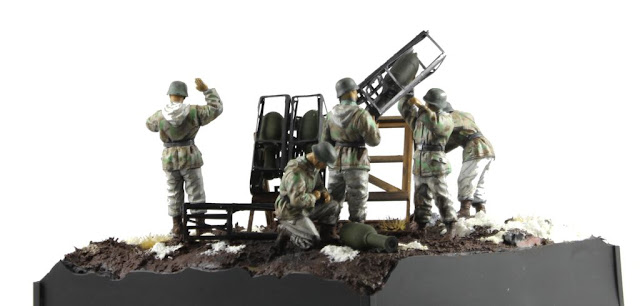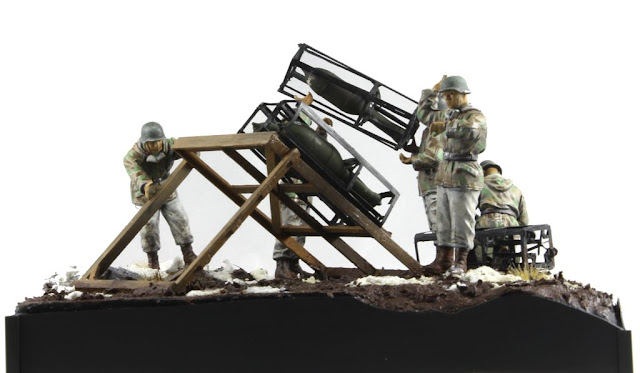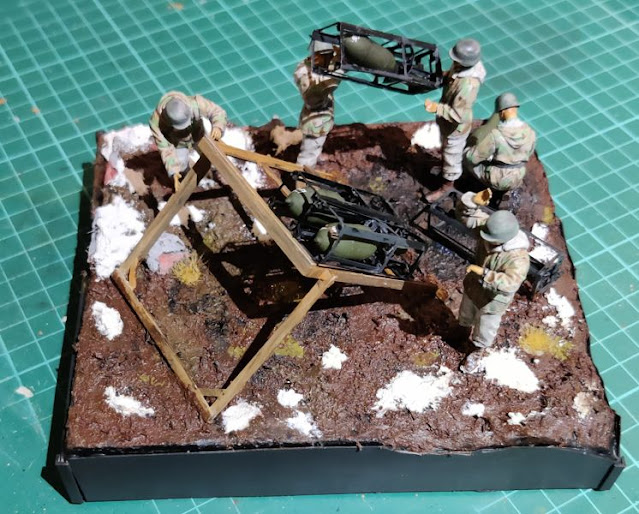Vallejo effects
Weathering was quite a wide term in this case, when the goal was to cover the diorama base with who knew what, and to get it to look like anything but a piece of styrofoam. Luckily I had a few products handy, so I didn't have to rely on just one type of goo.
These'd be a good start. The largest and newest jar (Vallejo DFX 26811
Brown Mud) was maybe predictably the one I'd use to cover most of the terrain. That'd be accompanied with european mud (VWE 73807) and maybe some of the mud and grass (VWE 73826). Finally I'd add use some snow (VWE 73820) to produce something like the end of Winter or early Spring.
All on brown mud
My first mud layer was pretty quickly spread on the terrain. I then added some euromud into the adjuster guy's lower right corner to make it a bit different in general. To the edges of the bumps I added some mud and grass, as far as it was spreadable.
Now was the moment to glue the wooden launcher rack into place. I used white glue as I didn't want to melt the XPS foam with the plastic glue at this point in the process.
Let it snow, let it snow
I gave the snow stuff a go and it behaved surprisingly well. The trial lumps were just tiny dollops, due to my worrying with a completely new product.
Earlier in life I had taken some reference photos of melting snow, just in case I needed them. The tiny mounds here had more vegetation in than what I was going for.
Another muddy layer
To make my terrain a bit more elevationally varied I add some more brown mud in various places. Over that I built more remains of melting snow banks, especially to the raised corner. That corner didn't feel right being both raised and also covered in runny-looking mud.
My second idea here was that where the launcher rack was, and especially right behind it, would be pretty much clear of snow, and more blown clear by the fiery jets of the rocket engines. I had no real life experience or self-witnessed memories of how any sort of a recoilless rifle or any rocket weapon's backblast area looked like. And I had not really paid that much attention of how the front side of the shield line of an artillery battery looked like after some rounds in the winter. So, like so much of my hobbying, it was done based on an unscientific gut feeling.
So far I had kept the black mud (VWE 73812) off my palette, because it was so strong in colour compared to the different browns. The fireblasting made me have a change of heart and I did use it, thinned and especially where I imagined the backblast to scorch the nature.
Detailing without mud
This made the muddy goo look pretty done to me. It wasn't all done yet, of course, I wanted some muddy puddles especially behind the launcher. While waiting for that to be done I superglued three tufts of grass (NOCH 07132
Grasbüschel Herbst) that had somehow remained half-alive from the Autumn. They'd give some tonal variety to this brownness.
That also gave me an idea how to improve the tinkerer's corner. I painted the straighter parts as rocks using cold grey (VGA 72750) and drybrushing them with stonewall grey (VGA 72750). Now this felt more reasonable, visually.
Adding some granite
The next day I realized that just grey stones were a bit boring if good addition. I took some more cold grey and mixed in some red and yellow ochre. This mix I tested into the first photo's lower left corner's rocklike piece and it felt good. Then I continued to another grey bit that I turned into a piece of granite. After a few corners and shades of grey-red I was content and stopped painting.
Mud puddles and meltflow
For the nasty mud puddles I mixed a bit of Dirt (VMA 71133) into gloss varnish (V 70510). With that I made a couple of puddles. When they flashed, we'd see how this worked in my terrain.
After doing the puddles I used some plain gloss varnish and added that along all the edges of the melting snow piles. The point of this was to emphasize the idea of the snow melting away, and that this patch of terrain was simply a disgusting place to walk in.
Crew
Painting the five-head crew of Germans got started by oil washing their camo coats and exposed skin with brown (ABT080 Brown Wash). My idea was to highlight especially the seams of the coats, and to make them a bit less pale. I was a bit concerned of how this'd work with the snow pants, so I didn't at least start with them. Being full white they would definitely benefit from their few highlights (or in this case the opposite) getting a bit of attention.
After some time I made some very thin Sepia wash (ABT002) and attacked the snow sides of the winter gear. When the paint had sat in for a bit, I cleaned up most of the paint while leaving the knees a bit dirtier than the rest. Those things could not remain pure white in the field, even if the weather was good.
These photos were taken immediately, so the guys needed a day or two to set. I didn't expect the difference to be enormous enough to take separate photos later on.
Mr A
This guy who was tinkering with the fuzes of the warheads was clearly someone who had crappier pant knees. Sadly there was nothing I could've put in his hands.
Mr B
One of the ammo carriers had remained relatively clean.
Mr C
This guy who had taken the heavier end of the Packkiste had also crawled more in mud than his buddy.
Mr D
The tinkerer's expression was a bit sad. Maybe his snow pants were already wet and cold.
Mr E
Sir team leader sir was clearly an old school superior who didn't waste time on the ground. His left boot showed how I had tried to use him as a footprint maker on mud and snow. That hadn't worked as I had hoped, but on his boot the snow looked good.
Attaching the loose pieces
Now, many evenings later, I was deep enough in the project that I could start gluing these guys onto the terrain. The big boss was the first one to go, being the one stanging alone on that side. Next one was the tinkerer on the opposite side of the launcher. Third one getting set was the kneeling dude, after which I did some figure-assisted measuring and glued the guy with the lighter end, because he had the worse ground options.
When these supergluings had been setting for a while I glued the last guy in while also playing with the Packkiste and its position. I never got the hands and the frame aligned perfectly, so I had them now as they ended up. Looking close up this made little sense, but from a distance it worked.
I also glued the final, empty Pacckiste, and the free-rolling 280mm HE rocket on the opposite side of the fuze-setter. There was a bit of an element of danger for someone falling, luckily there was no banana peel on the ground.
This was just about done now. I left the superglue to flash before going for the last touchups.
The final mud/snow tweaks
I devoted the melting snow piles some more attention. A few got more mass from fresh lumps, and a couple of others I expanded a bit. Those shoes that were next to snow piles, got some snow applied on them to make them fit in better.
Using the same idea I applied some brown mud by almost everyone's feet and on many boots, as far as they stood next to this stuff. Mostly the guys had crowded behind the rocket launcher, which was somehow dominated by the darker mud, so I used plain black mud to include them. I also used some black mud to reinforce the rocket-scorched look here and there. A few knees also got some mud on them to make it so very clear that this was a nasty place and time.
These latest photos showed the freshly modified parts more shiny than what they'd be after a bit of time. I also used some satin varnish on the exposed skin of all five crewmembers, just like I did with the ancient submarine captain.
While on the varnishes I was thinking if the helmets ought to be satin-varnished as well, being made of stell and all, but I let them be. Just like I had thought of whitewashing a helmet or two some dozens of hours earlier. Sometimes one had to know when to stop :)


















































